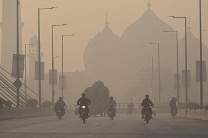
Smog has turned Lahore from a ‘city of gardens’ to one of the most polluted cities in the world. Historically, The Mughals designed the city of Lahore around the concept of a garden. However, with a surge in the number of concrete buildings, its green spaces are becoming increasingly scarce.
Unregulated urbanization, excessive air pollution due to toxic emissions, poor waste management, and increased amount of traffic has created a hazardous situation for the city’s environment. As a result, every year Lahore has begun to experience a wave of smog during the fall season which continues well into the winter months.
According to IQAir Air visual live ranking of global cities, Lahore has been ranked as the most polluted city at the start of January 2022.[1]
Impact of Smog
Accelerated by high levels of pollution, smog has severe effects on Lahore’s inhabitants like deteriorating health conditions, disrupted flight operations, and visibility issues for road traffic.
In terms of health issues, smog has been responsible for causing excessive breathing issues, eyesight problems and headaches. If left unchecked, smog can have fatal outcomes such as lung cancer.
Apart from health, smog also results in disruption of flight operations. Every year the Civil Aviation Authority is forced to delay and cancel many flights as a result of zero visibility caused by the smog. Lahore’s International Airport is an important hub for economic activities. The delaying and cancelation of flights due to smog causes innumerable losses to the economy as everything comes to a halt.
Not only flight operations but also road traffic faces hindrances from smog. The flow of traffic is disrupted as drivers and riders are unable to see. This may result in unnecessary traffic blockades which lead to more air pollution and also disruptions in daily life activities. Smog affects the education and employment sectors, as people are forced to stay home to protect their health. Schools are often forced to close campuses as a result of the poor air quality students have to experience while traveling to school.
Recommendations
Severe effects of smog demand some dynamic policy options, these include:
- To avoid health issues caused by smog, it should be made mandatory for people to wear masks and glasses so that smog may not affect their breathing ability and eyesight.
- Government and other monitoring agencies should ensure environmentally friendly transport systems. Government should introduce the Electric Vehicle Supply Scheme so that pollution may be minimized as traffic is a major contributor to pollution in the city.
- Social and economic activities of the masses must be monitored. Pollution in Lahore is not entirely caused by the citizens of Lahore, nearby areas are also responsible for this environmental catastrophe.[2] Therefore the administration of the causes of smog should go beyond the city boundaries.
- There should be an environment related awareness system for locals. Awareness can be created through educational institutions by holding seminars on how to make our daily life activities more sustainable and environment friendly. The span of the awareness can be expanded by distributing the pamphlets among masses. For this purpose, youth can play an active role by collaborating with district administration and giving awareness to their own local networks. Building on social capital is an important tool to consider when it comes to raising awareness.
- Residents of Lahore should prefer using public transport rather than private transport especially while moving within the city. Lahore has three public transport systems: North to South – Metro Bus System, East to West – Orange Line Metro Train, and for on road movement Speedo Feeder Bus, which almost covers all parts of Lahore. In this manner, on road traffic will be lessened and that will be helpful in producing less air pollution. Bottlenecks that hinder people from using public transport must be dealt with. Improving efficiency, punctuality and cleanliness of public transport, ensuring safety for women and children and facilitating disabled access are all important areas to work on.
Smog has pushed Lahore to the top rank of most polluted city in the world while paving way for change in seasonal patterns. It is also contributing towards bad public health and sluggish economic activity. However, the damage is not irreversible yet. Preventative measures and policies like monitoring public and private transport, ensuring environment friendly activities and giving awareness to the locals, can minimize the intensity of smog. It is pertinent for all concerned stakeholders to raise their voice and communicate viable policy options for making the city of Lahore sustainable and environmentally safe for everyone.
About the author

Muhammad Shahid is currently a student of MPhil. Public Policy at CPPG. His research interests include social issues and civil society.
References:
Ali, Syed Mohammad. “How Lahore Became the World’s Most Polluted Place”, Foreign Policy. (2021) https://foreignpolicy.com/2021/11/29/pakistan-lahore-pollution-fossil-fuels-climate/ (Access date: March 07, 2022)
“Lahore Air Quality Index”, IQAir. (2022) https://www.iqair.com/pakistan/punjab/lahore (Access date: Feb. 22, 2022)
“Pakistan’s Lahore again tops world’s most polluted cities list”, Al Jazeera. (2021) https://www.aljazeera.com/news/2021/12/3/pakistan-lahore-tops-most-polluted-cities-list (Access date: Feb. 22, 2022)
Citations

